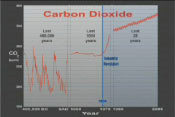 |
NASA | GSFC | JPL | Site Map |
|
|
 |
 |
Education: Student Outcomes |
Click here to search for other assets Keeping Up With Carbon: Human-Generated Carbon & Ocean Change Grade level: 9-12 Themes: climate, water cycle Video: keeping_up_carbon_03.flv
Researchers are learning that future climate change will depend on carbon levels in the land, in the atmosphere, and in the sea, and how these levels respond to human disturbance. About one-third of all human-generated carbon emissions has dissolved into the ocean. More than 80% of Earth's added heat is now stored in the ocean. Scott Doney: "In the future, as the planet gets warmer, the water's going to warm up, and warm water can hold less carbon than cold water - the other thing is, on a warmer planet, some of the currents are going to slow down, so we might not be forming as much of this cold deep water. So we won't be able to transport carbon into the deep sea. So on the whole, the ocean's going to become less effective at removing carbon from the atmosphere." (source) Student Outcomes After viewing this video, students should be able to: Explain how climate variations can induce changes in the global ocean circulation. (C: 9-12) Determine if global precipitation, evaporation, and the cycling of water are changing. (W: 9-12) Key: C = climate / O = ocean circulation / T = 21st century technology / W = water cycle |
|||||
